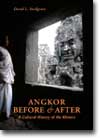| Our Publications | ||
| Books by Title | ||
| Books by Author | ||
| Books by Country | ||
| E-books | ||
| About | ||
| Orchid Press E-books | ||
| Distributed E-books | ||
| Our Bookshop | ||
| About Us | ||
| Browse Shop | ||
| How to Buy | ||
| Contact Us | ||
| WE BUY BOOKS AND LIBRARIES | ||
|
||
Book Reviews

Angkor—Before and After:
A Cultural History of the Khmers
byDavid Snellgrove
2004. 264 pp., 236 col. pl, 3 figs, 10 maps, bibliography, index, 290 x 210, Hardcover.
ISBN-10: 974-524-041-9 $60.00
ISBN-13: 978-974-524-041-4
Cambodia is just one part of the story
Book review by Tim Winter
(The Times Higher Education Supplement, April 1, 2005)
Along with the manufacturers of sunscreen, cameras and suitcases, one of the more unlikely beneficiaries of our obsession with tourism and travel has been the coffee-table book industry. Expeditions to exotic, historic or visually stunning locations invariably serve as an excuse for purchasing yet another heavyweight hardback. Trips to Cambodia are no exception. In recent years, tourists visiting the country have been given ample opportunity to adorn their lounges with more glossy pages. In Publishing Angkor-Before and After, David Snellgrove adds another volume to that choice.
To differentiate his latest offering from the repertoire of publications on Angkor, the author adds the subtitle A Cultural History of the Khmers. The introductory notes elaborate on his intention to reach an audience interested in Khmer culture beyond the well-trodden tourist sites at Angkor. Arguing that previous publications on Cambodia and the Khmer civilisation have been “aimed at the casual tourist, or alternately, have consisted more or less of esoteric monographs, highly focused on specific aspects of Khmer culture”, his text sets out to bridge this gap by providing “a new cultural history of the Khmers covering the period from its very beginning in the 5th Century right up to the present day”. The degree to which he succeeds in achieving this is open to question.
Over a long and distinguished academic career. Snellgrove has extensively published on South Asian art, Buddhism and Sanskrit texts. Since retiring in 1982, his attention and passion have geographically shifted towards Southeast Asia. The author, a resident in the region for more than a decade, has focused his gaze on Khmer art and culture. The current title builds on his previous pocket guide Khmer Civilisation and Angkor (2000), also published by Orchid Press.
Largely based on first-hand research, Angkor—Before and After is testimony to the author’s extensive efforts to visit architectural ruins and other sites in Cambodia and neighbouring Thailand. With lengthy descriptions of numerous remote locations, he offers a comprehensive overview of pre-modern Khmer architecture and sculpture. The book benefits from a vast array of photographs, many of which were taken by Snellgrove. These vary in quality, but the combination of images from site visits and museums nicely supplements the textual descriptions. Given that the author explicitly sets out to provide the reader with a sense of how Khmer culture and civilisation has historically and geographically extended beyond the Angkor region, it would have been helpful to have had more detailed maps.
In early chapters, the author weaves material from temple sites, inscriptions, sculptures and monastic architecture. Integrating these sources from across a wide geographical area, Snellgrove provides an account of Khmer history beyond the more popular sites of Angkor. Descriptions of monarchs, the extent of their domains and the artistic evolution of Khmer carving and architectural ornamentation are lively and detailed.
With the post-Angkorean period conventionally understood as an era of decline, there has been a tendency to orient Khmer historiography primarily around monumental architecture. This reliance on stone has been reinforced by the belief that much of Cambodia’s cultural past was destroyed in the Khmer Rouge regime of the late 1970s. Snellgrove’s account does little to depart from this construction of Cambodian history. Examples of vernacular culture such a ceramics, everyday practices or domestic architecture are rarely explored. These are notable omissions given the proliferation of studies recently conducted in Cambodia and Thailand into such areas. The chapters covering the 13th to 16th and 17th to 19th centuries are a case in point. While providing lengthy accounts of pagoda architecture, rituals and the biographies of successive monarchs, these chapters would have benefited from a discussion of Khmer culture understood in more social or vernacular terms.
In addition to viewing culture through a lens of religious architecture, sculpture and inscriptions, the author also principally examines the Khmers as a “highly developed medieval civilisation”. As a consequence, the mere eight pages covering the 19th to 20th centuries are regarded as an “epilogue”. By implication, little attention is given to formations of Khmer culture within the contexts of French colonialism, modernisation or post-independence nation-building. With its reliance on Angkor as the omnipresent parameters through which Khmer cultural history is framed, valued and understood, the book rarely examines areas such as dance, theatre, costume, puppetry, cuisine or every day architecture. In this respect, Snellgrove’s account of Khmer culture as a “classical” architectural and artistic heritage does not represent a radical departure from the majority of other publications on Cambodian and Khmer history available.
But in a market crowded with texts dedicated to Angkor, this book will be of interest to those readers who wish to learn more about how Khmer art and architecture is situated within its broader geographical and historical context. By illustrating the extent to which a “classical” Khmer culture spread beyond the boundaries of modern-day Cambodia, Angkor—Before and After represents a valuable contribution to any coffee-table collection dedicated to understanding pre-modern Cambodia and Southeast Asia.
[Read a review from The Journal of the Siam Society] [More Orchid Press Reviews]
PO Box 70, Trinity TB, NL, A0C 2S0, Canada
Telephone: +1 709-330-4703